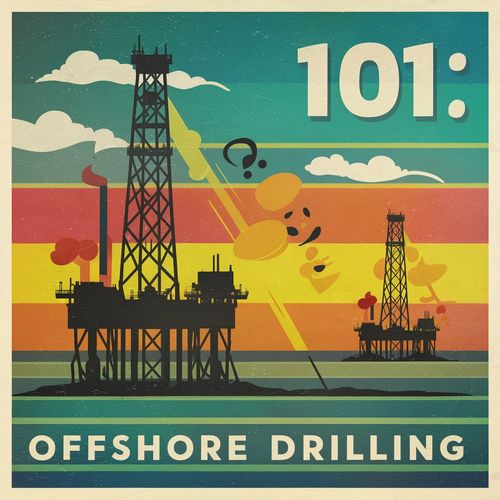Many investors have written off the beleaguered offshore drilling industry after a painful decade of low oil prices, project delays, and restructurings. However, important fundamentals have shifted under the surface that could set the stage for sizable gains in the coming years. In this article, I explain crucial background and recent changes in oilfield economics to make the bullish case for a potential offshore drilling renaissance.
What is Offshore Drilling and Why Does it Matter?
Offshore drilling refers to extracting oil or natural gas from reservoirs located underwater on continental shelves or further out to sea. Major global oil companies like ExxonMobil, Chevron, Shell, TotalEnergies and Petrobras hire special drilling rigs and crews from contractors like Transocean, Diamond Offshore and Noble Corporation. These complex assets can cost over $1 billion each.
Deepwater offshore wells produce around one-third of the world's oil supply. Mature onshore basins face steeper production declines. Industry experts forecast deepwater spending needs to double from current levels to compensate for the natural 4-5% annual drop in global oil output. That creates a strong incentive for oil majors to invest more in large offshore projects in the years ahead.
Why the Gloom and Doom Perspective Emerged
In the aftermath of the 2014 oil price collapse, investor sentiment on offshore drilling turned decidedly negative for good reason. Brent crude plunged below $30 per barrel early in 2016, devastating the economics of long-cycle offshore projects. An explosion of light tight oil (LTI) growth from US shale basins compounded concerns by offering cheaper and faster production growth.
Dozens of new ultra-deepwater drillships ordered during the previous commodity boom arrived just as demand fell off a cliff. Dayrates on drilling rig contracts plunged as well. The resulting perfect storm of oversupply and stretched customer budgets pushed most offshore drilling companies into bankruptcy between 2015 and 2017.
Light at the End of the Tunnel
However, green shoots have emerged in recent years that suggest a more constructive outlook for offshore drilling stocks after this painful downturn. Costs of offshore development have steadily improved while shale's growth outlook has moderated. These shifting dynamics, combined with high oil prices in 2022, have reignited customer interest in signing long-term rig contracts to support new offshore projects.
Catching Up to Shale on Economics
During the US shale revolution last decade, technical innovations like horizontal drilling and hydraulic fracturing opened up vast quantities of lighter oil. Break-even costs to drill shale wells dropped as more vitallow as $30 per barrel, proving cheaper than most deepwater projects at the time. Offshore players found themselves stuck between a rock and a hard place when oil sank to $26 briefly in 2016.
Since then, shale drilling productivity has waned slightly as companies shift activity from "sweet spots" to lower quality acreage. Deepwater drillers and oilfield service companies brought offshore development costs down considerably as well. Estimates suggest full-cycle offshore project breakevens now range from $45 to $65 per barrel, largely overlapping with shale prospects economic at $50 to $70 per barrel. Cost parity brings offshore projects back into consideration for oil companies eyeing future output growth.
Few Incremental Rigs Available
One element that caught the industry off guard last cycle was the enormous shadow orderbook of new deepwater drillships still under construction as oil prices crashed. Yards continued building dozens of speculatively ordered vessels meant for a much healthier market. As these state-of-the-art rigs delivered into weak conditions between 2016 and 2019, they crushed spot dayrates and left older vessels increasingly obsolete.
Today the pendulum has swung the other way. Oil company customers are already bidding up rates to find available equipment suitable for harsh environments like offshore Norway or ultra-deep wells over two miles deep. However, after the pain inflicted last decade, drillers remain extremely reluctant to commission new rigs on spec despite rising demand. Their focus lies more on paying down debt or buying back discounted shares.
My analysis suggests these "stranded" newbuild drillships still looking for their first contracts have dwindled down to a handful. ExxonMobil, TotalEnergies and regional national oil companies have secured most of the modern capable rigs in recent years. Otherwise customers face long waiting lists at shipyards driving costs above $1 billion each. This scarcity limits excess capacity from pressuring dayrates during the upcycle underway.
Reading the Exploration Tea Leaves
Perhaps the strongest confirmation of improving offshore activity comes from watching where oil companies actively explore for new resources. High profile global discoveries like Guyana and Brazil's pre-salt basin require significant further appraisal drilling before launching production. Meanwhile majors continue acquiring additional licenses to explore frontier regions of Namibia, Uruguay and northern Brazil.
Each new exploration campaign directly drives incremental demand for offshore drilling rigs and services. While geological success rates range anywhere from 20% to 50%, enough large strikes can support considerable development drilling, subsea equipment orders and floating production facilities down the road. This is already apparent given the giant Guyana discoveries look likely to produce over 1 million barrels per day before 2030.
Patience Remains a Virtue with Timing
Given long development lead times, investors still need patience allowing for ups and downs in sentiment over the next few years. But conditions seem increasingly primed for offshore drilling stocks like Transocean, Borr Drilling and Valaris to rebound materially from bombed-out levels hit during 2020's oil crash. Debt burdens have eased after restructuring. Rig tendering activity is the strongest in years. Most importantly the need for expensive offshore production looks more vital than ever as the world demands more energy sources.

